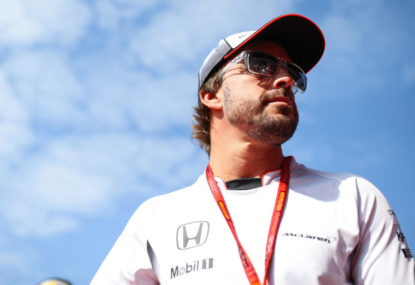Fernando Alonso's future is secure, now it's Lance Stroll's time to deliver for Aston Martin
It’s time that serious questions are asked of his Lance Stroll and his future in the team.

The news of the divorce between McLaren and Honda at last was made official over the Singapore Grand Prix weekend, ending a disastrous three-year spell between the two Formula One heavyweights.
A flurry of press releases following the first practice session on Friday, confirmed that McLaren and Honda would be ending their collaboration, that French manufacturer Renault would be the new engine supplier for McLaren and that Red Bull junior outfit Toro Rosso will be the new Honda works team for the next three seasons.
Supplementing the engine supply shuffle, was the news that Carlos Sainz would be loaned out from Toro Rosso in 2018 to the works Renault outfit, ousting the lacklustre Jolyon Palmer.
It would appear as if all parties involved here comes out a winner, with McLaren at last having hope of being competitive with Renault, Honda to face less scrutiny at Toro Rosso and Sainz who has been freed, temporarily as we are led to believe – from the shackles of the Red Bull empire.
McLaren, whom have been winless in Formula One since 2012 and been without a podium since 2014, will be entering 2018 with renewed hope that they can be a force in the sport.
While it isn’t expected that they’ll be instantly returned to the upper echelon, currently comprised Mercedes AMG and Ferrari – the onus is that they will be equal to Red Bull, now having the same power supply.
With that, a great level of expectation does befall the Woking outfit. Having bemoaned the Honda power-unit for their lack of competitiveness over the past three seasons, there will be nowhere to hide for McLaren if they will be directly challenging Red Bull – as supremacy will come down to who has the superior chassis.
Long have McLaren claimed that they possess a chassis that is capable of regularly mixing it with the top teams, though without the right power-unit – any ambition to demonstrate that has been naught.
In the Renault, McLaren will have a reliable power-unit. While the overall performance may still lack in comparison to Mercedes-Benz and Ferrari, Renault certainly have a stronger foundation to work from than Honda. With three, strong teams set to wield Renault power in 2018, the only way is up.
It would be expected that as a result of this new partnership, that McLaren will retain the services of the despondent Fernando Alonso, whom could be argued was the instigator in mounting the pressure on Honda.
There is little chance that the dual-world champion will be able to add that elusive third title to his tally, now that he edges into the twilight of his career – though being in a competitive car could renew his vigour to stay in the sport beyond 2020, where it is expected that McLaren will begin building engines in-house.
As deeply disappointing as it is to see the McLaren-Honda collaboration bare no fruit, this outcome is the best for both parties. After haemorrhaging countless amounts of money and sponsorship, the new McLaren spearheaded by Zak Brown must start with a clean slate, if they are to earn new sponsors.
Honda will be grateful that after their embarrassing exercise with McLaren, that at the desire of Formula One CEO Chase Carey, that they will remain in the sport. With a team like Toro Rosso, there will be less scrutiny on delivering top results and for the energy drinks giant – they will be able to pocket some coin on having free engines.
It remains to be seen whether Honda will make significant gains during the off-season, though it has firmly stated that there is the potential to be a ‘top-three’ competitor in 2018 with Toro Rosso.
The logic from here is that Red Bull, as an organisation will use their junior outfit in Toro Rosso to have Honda develop their power-unit to a stage where Red Bull Racing can sever ties with Renault and become powered by the Japanese manufacturer.
Whether will be a long-term project or not, with Red Bull team principal Christian Horner insinuating that his outfit will be powered by British road-car maker Aston Martin from 2021 – the energy drinks giant can at last complete their slow divorce with Renault, which started in 2015.
Young Spaniard Sainz’s benefit from leaving Toro Rosso and going to Renault, also fulfils the 23-year-old’s desire to be driving for a top team.
Having spent most of his Toro Rosso career in the shadow of Max Verstappen, Sainz can now forge a path of his own at the team where his childhood hero in Alonso won his two titles.
Difficult it is to pick out any losers from this outcome, apart from Jolyon Palmer who will unlikely feature on the Formula One grid altogether in 2018. Though the Briton’s time in the sport was marked, as known.
The 2017 season is far from over, though for the involved parties of this shuffling of engine suppliers – there is renewed optimism for 2018, which couldn’t come sooner.